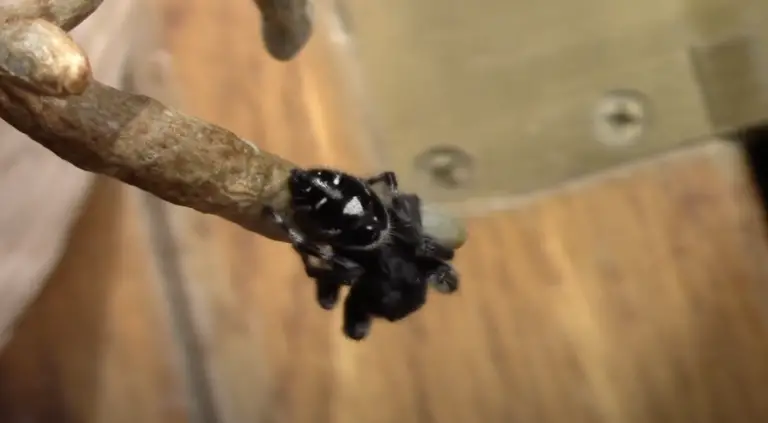Phidippus Audax
Phidippus audax belongs to the Salticidae family. They are also commonly known as the bold jumping spider or bold jumper.
Name
In their name, audax translates to audacity, which is why these jumping spiders have been given the names bold jumping spider and daring jumping spider.
They are also sometimes referred to as the common jumping spider.
Geographic Range
Bold jumping spiders are often found throughout the US, like California and Pennsylvania, as well as in southern Canada and northern Mexico. This species has also been found in Cuba and has even been introduced to Hawaii. These areas are all largely dry, but the bold jumping spider can also be found in rainforests and woodlands.
If kept as pets, the elements of the warmer climates in these areas should be replicated. This means that the humidity should be kept between 30-70%, and the temperature should be kept between 21-29C. For these conditions to be consistent, a thermostat should be used at all times.
Natural Habitat
Similar to most jumping spiders, bold jumping spiders can be found in fields and grasslands. They frequently reside on vertical surfaces, like fences, walls, and backyards; this is especially common when it’s warm outside, and they can bask in the sunlight’s heat. These spiders likely prefer flat vertical surfaces for hunting.
When kept as pets, bold jumpers can be kept in enclosures or terrariums that copy their natural environment. Having a variety of items for these spiders to climb, like cork bark and plants, provides them with much-needed enrichment.
Appearance
The phidippus audax has a dark body with a light-colored pattern of spots and stripes. Their chelicerae usually take on an iridescent green hue. On the abdomen, there are two rows of white spots, which are separated by black stripes. The legs are black with white stripes and spots.
The bold jumper is a medium-sized spider. Adult males range between 6-13mm while adult females range between 8-19mm.
The males of this species are also much more brightly colored than the females, although both sexes have similar patterns. These spiders have black bodies with starkly contrasting markings, which are white spots and stripes. This is why bold jumpers are often mistaken as male regal jumping spiders (phidippus regius) and vice versa. You can read more on the regal jumping spiders here.
Their very keen eyesight is the result of four pairs of eyes; these eyes are set in the pattern that is unique to jumping spiders.

Lifespan
P audax jumpers typically have a lifespan of one to two years.
Life Cycle
The phidippus audax females produce multiple clutches of eggs throughout their lifetimes. Clutches tend to contain between 100 and 300 individual eggs. These eggs are often found on the underside of leaves or a flat surface, like a stone or a fence. After about a month, the eggs hatch, and the spiderlings develop. They will be gray-colored with white spots and stripes.
The spiderlings often stay on the web for about a week until they have gone through their first molt, then they begin to disperse.
Several more molts will occur before bold jumpers mature; these molts allow them to shed their exoskeletons and grow. Frequent feedings can cause quicker molting, as this can affect their growth rate. A bold jumper who is fed more often will outgrow their exoskeleton sooner.
Males reach adulthood within a few months due to being smaller, while females take a little longer and can take up to nine months to mature. Their differing size makes it easier to differentiate between male and female.
When it comes to mating, male bold jumpers appear to be easily pleased, but females are much more selective when choosing potential mates. If both sexes approve of a chosen mate, then copulation begins.
Behavior
Bold jumping spiders jump, of course, as do all spiders in the jumping spider family. Their ability to jump stems primarily from their powerful hind legs; the back legs are used to propel the spider through the air. They can climb on vertical surfaces and even glass, as long as it is fairly clean.
Most spiders use webs for hunting, but not jumping spiders. Jumping spider silk is used for safety and security, like when they are sleeping, molting, and creating their egg sacs. Their silk is also used as bungee cords that protect them from falling when a leap fails.
Mating is another unique behavior of jumping spiders, and bold jumpers follow this. When a male jumper finds a suitable partner, he begins a pattern of visual communication with the female to register his interest in her. This dance involves a lot of leg lifting to impress the female.
Phidippus audax rarely bites humans; like most jumping spiders, this species is particularly docile. Many people wonder, “are phidippus audax spiders poisonous?” While they do have venom, it rarely causes a reaction in people. These spiders are more likely to freeze or run from predators, only fighting when their other options aren’t available. But if you do get bitten by a P audax spider, then you should read this post.
Diet
These carnivorous predators hunt and locate prey using their impressive eyesight. Bold jumpers have excellent vision and have three pairs of eyes: two large principal eyes and two smaller secondary eyes. Their sharp vision allows them to stalk prey at a distance before leaping from above. Their hunting behavior allows them to target roaming insects easily.
The phidippus audax eats various small to medium-sized insects, such as flies, crickets, and mealworms. As they slightly differ in size, males prefer smaller prey and females prefer larger prey. It is also worth noting that male Phidippus audax spiders might not eat as much as females due to their size.
Like other jumping spiders, as long as bold jumping spiders have water, they can survive for weeks – sometimes months – without food.
